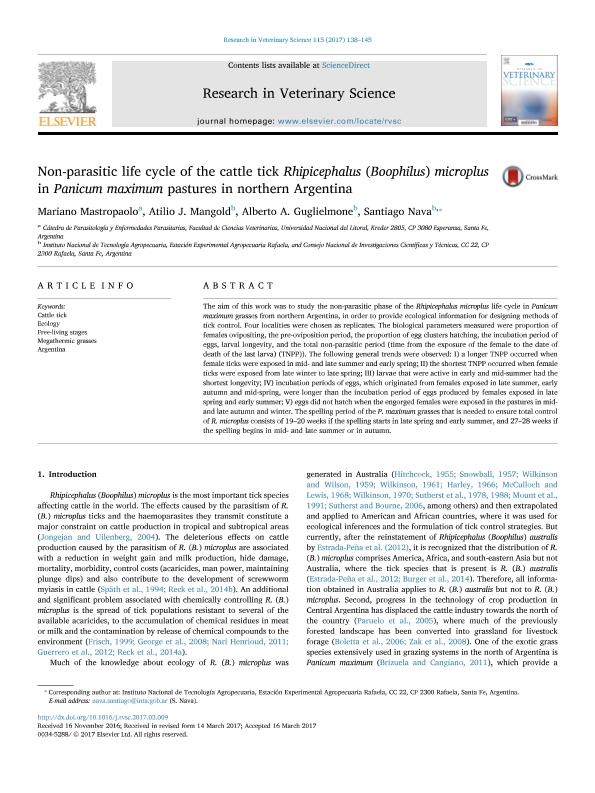Artículo
Non-parasitic life cycle of the cattle tick Rhipicephalus (Boophilus) microplus in Panicum maximum pastures in northern Argentina
Fecha de publicación:
12/2017
Editorial:
Elsevier
Revista:
Research in Veterinary Science
ISSN:
0034-5288
Idioma:
Inglés
Tipo de recurso:
Artículo publicado
Resumen
The aim of this work was to study the non-parasitic phase of the Rhipicephalus microplus life cycle in Panicum maximum grasses from northern Argentina, in order to provide ecological information for designing methods of tick control. Four localities were chosen as replicates. The biological parameters measured were proportion of females ovipositing, the pre-oviposition period, the proportion of egg clusters hatching, the incubation period of eggs, larval longevity, and the total non-parasitic period (time from the exposure of the female to the date of death of the last larva) (TNPP)). The following general trends were observed: I) a longer TNPP occurred when female ticks were exposed in mid- and late summer and early spring; II) the shortest TNPP occurred when female ticks were exposed from late winter to late spring; III) larvae that were active in early and mid-summer had the shortest longevity; IV) incubation periods of eggs, which originated from females exposed in late summer, early autumn and mid-spring, were longer than the incubation period of eggs produced by females exposed in late spring and early summer; V) eggs did not hatch when the engorged females were exposed in the pastures in mid- and late autumn and winter. The spelling period of the P. maximum grasses that is needed to ensure total control of R. microplus consists of 19–20 weeks if the spelling starts in late spring and early summer, and 27–28 weeks if the spelling begins in mid- and late summer or in autumn.
Palabras clave:
Argentina
,
Cattle Tick
,
Ecology
,
Free-Living Stages
,
Megathermic Grasses
Archivos asociados
Licencia
Identificadores
Colecciones
Articulos(CCT - SANTA FE)
Articulos de CTRO.CIENTIFICO TECNOL.CONICET - SANTA FE
Articulos de CTRO.CIENTIFICO TECNOL.CONICET - SANTA FE
Citación
Mastropaolo, Mariano; Mangold, Atilio Jose; Guglielmone, Alberto Alejandro; Nava, Santiago; Non-parasitic life cycle of the cattle tick Rhipicephalus (Boophilus) microplus in Panicum maximum pastures in northern Argentina; Elsevier; Research in Veterinary Science; 115; 12-2017; 138-145
Compartir
Altmétricas




